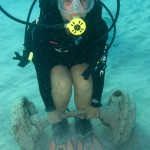The plan… Arrive at Mahukona in the mid-afternoon, do an afternoon dive. Then we fire up a barbeque and have dinner, talk story and watch sunset from a beautiful Hawaiian shore. When it gets dark we load up a second tank and head back out for a night dive. Not a bad plan! I have not been night diving in quite a while, so when the plan was suggested I readily agreed.
Our group contained several folks who had never dove Mahukona. Thus the afternoon dive plan was obvious, head for what remains of the SS Kauai, visiting the engine and propeller, exploring scraps of the cargo. From there we headed out onto the coral beyond, exploring the reef due west of the engine to a depth of about fifty feet. It was a nice afternoon dive, nothing particularly exciting found. I noted the behavior change in many fish, seen as the light begins to fade. While not yet dark, it was apparent that the fish were readying for night, hovering close to chosen coral heads, awaiting the coming darkness.

Mahukona is an excellent choice for a night dive. The landing is easy to find, there is a streetlight atop the old sugar wharf to guide you back in. There are no particular navigational hazards, no large rocks or coral heads to run into as you swim out and back. We had a couple less experienced divers along for this outing, so an easy site was a good choice. The afternoon dive allowed those of our group unfamiliar with the cove to explore and learn the area.
Night diving is an exercise in taming those ancient instinctive fears that gibber at the back of your mind. As I swim out into the inky black water I have to firmly tell those primitive fears to shut the #*&@ up. Yes there are risks, yes there could be a 15ft tiger shark hovering just beyond the reach of my light, but I will do this. I turn and look at the stars, and let the fears slide away in the beauty of the moment.
Our decent is delayed by a gear problem with one of the divers. As it is resolved we float in the center of the cove a hundred yards from shore. A bit of chatter among the divers, but mostly we just lie back and gaze at the stars. A gentle swell rocks us in the warm salt water, a full Moon rises high in the east. There is a common ascent in the conversation, the beauty of this moment is priceless.
Problems resolved, we rendezvous over the old steam engine. Agreeing to the plan, we perform the final checks. I press the button, releasing the air in my BCD to descend into the black. I note the position of the Moon as I slip under, it is going to be easy to keep oriented, just look for the glimmer of moonlight at the surface to head for shore.
A night dive is a surreal experience. In many way it is the same as diving the reef in the day… the same coral formations, the same sounds from the snapping shrimp, the same the hiss and gurgle of your regulator. As long as you are looking close at the coral under the light it is possible to mistake the time of day. Allow yourself to drift up from the coral, hovering above the reef and there is no comparison. The gloom hovers at the edge of your lights, punctuated here and there by the lights of fellow divers. Everything else is lost in blackness. Gone are the swarms of brightly colored reef fish, there is little movement, what there is seems furtive and darting.

As usual I measure the success of a dive by the number of photos I consider decent. This dive produced quite a few. Species of fish that are not seen in the daylight, and other fish who change colors by night, assuming unfamiliar patterns. I find a starfish crossing the sand in search of prey, another resident who hides from predators by day, buried in the sand. I find my first gumdrop, probably Berthellina delicata, similar in appearance and habits to the nudibranchs I am looking for, but belonging to a different order. I recognize it immediately from the photos I have seen. Happy with the find I set out to get a couple photos despite it’s difficult location in a crevice.
Even the rocky shallows near the pier are productive. Among the cobbles I find critters and fish not normally seen in the day. I have just a bit of air left, well into my reserve, not much of a safety risk when I am in four feet of water. A small scorpionfish allows me several shots before disappearing into the dark. Brittlestar tentacles appear out from under every rock.
Arriving back at shore we are exhausted and elated. As we doff gear everyone seems to have enjoyed the night dive. We must do this again sometime!

